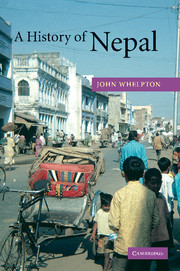Book contents
- Frontmatter
- Contents
- List of illustrations
- List of maps
- List of tables
- Key events
- Acknowledgements
- Notes on romanisation and terminology
- List of abbreviations
- Introduction
- 1 Environment, state and society in the central Himalayas to 1743
- 2 Unification and sanskritisation, 1743 – 1885
- 3 Nepal under the Shamsher Ranas, 1885 – 1951
- 4 The monarchy in ascendance: domestic politics and foreign relations, 1951 – 1991
- 5 The quest for ‘development’: economy and environment, 1951 – 1991
- 6 Lifestyles, values, identities: changes in Nepalese society, 1951 – 1991
- 7 Democracy and disillusionment: Nepal since 1991
- Genealogical tables
- Biographical notes
- Notes
- Glossary
- Bibliography
- Index
3 - Nepal under the Shamsher Ranas, 1885 – 1951
Published online by Cambridge University Press: 05 June 2016
- Frontmatter
- Contents
- List of illustrations
- List of maps
- List of tables
- Key events
- Acknowledgements
- Notes on romanisation and terminology
- List of abbreviations
- Introduction
- 1 Environment, state and society in the central Himalayas to 1743
- 2 Unification and sanskritisation, 1743 – 1885
- 3 Nepal under the Shamsher Ranas, 1885 – 1951
- 4 The monarchy in ascendance: domestic politics and foreign relations, 1951 – 1991
- 5 The quest for ‘development’: economy and environment, 1951 – 1991
- 6 Lifestyles, values, identities: changes in Nepalese society, 1951 – 1991
- 7 Democracy and disillusionment: Nepal since 1991
- Genealogical tables
- Biographical notes
- Notes
- Glossary
- Bibliography
- Index
Summary
The Shamsher Ranas ruled Nepal for sixty-six years from 1885. It was a period that saw the beginnings of the takeoff in population growth and, consequently, increasing pressure on land in the hills. These years also brought the tightening of the economic bonds between the Nepalese and Indian economies and the slowly increasing exposure of Nepal's people to new ways of thinking from India and the world beyond. These were, however, long-term processes and, particularly in the earlier part of the period, they did not make a strong impact on political developments. Here the important factors were the jockeying for power within the Rana family itself and also the regime's relationship with British India. Co-operation with the British had been the norm since even before Jang Bahadur's takeover, but it was strengthened by the accession to power of a new generation of Ranas. All had been educated to some level in English and, while still a little wary of British intentions, they did not feel the deep suspicion of firangis which Jang had shared with all Nepalese statesmen before him. The new attitude was also helped by a major change in British policy in India after the Mutiny crisis of 1857. Whereas before they had seemed intent on elbowing aside traditional rulers and substituting their own direct administration, greater caution now ruled, and the British were anxious to sustain rather than supplant what remained of traditional political structures. With the rise of the Indian nationalist movement around the turn of the century, this more conservative stance was further reinforced because such rulers – whether the Indian ‘princes’ or the Ranas in Nepal – seemed natural allies against radical demands for political change.
FROM BIR TO BHIM: THE HIGH TIDE OF RANA RULE
The system of agnate succession continued after 1885, and the joint position of maharaja and prime minister was held in turn by five of Dhir Shamsher's sons and then by two of his grandchildren.
- Type
- Chapter
- Information
- A History of Nepal , pp. 61 - 85Publisher: Cambridge University PressPrint publication year: 2005
- 1
- Cited by



